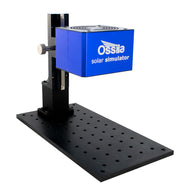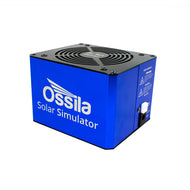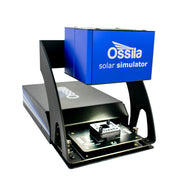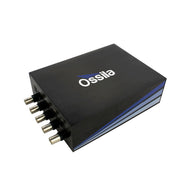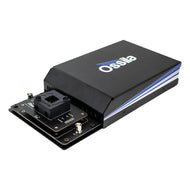Radiometry and Photometry
Quantitively, the measurement of light can be quite confusing as there are different ways to describe the amount of light emitted from a source and the amount of light received by a surface. Beyond this, light can be measured either photometrically or radiometrically.
Radiometry is a measurement of electromagnetic radiation (or radiant energy) emitted by source, often defined in terms of power. Radiometric measurements extend past the visible region of the electromagnetic spectrum, into the infrared and ultraviolet. Radiometry is typically used to measure the total power output of an object in the infrared, visible, or ultraviolet spectrum, or to measure the spectral power distribution of a source.
Photometry is a measurement of light in relation to its brightness as detected by the human eye. This measurement is only concerned with light in the visible region of the electromagnetic spectrum, which can be seen by the human eye. Photometry is typically used to measure the intensity, spectral distribution and colour of light sources.
Below we describe some of the common quantities associated with the measurement of light — both photometrically and radiometrically.
Solar Cell Testing Kit

- Unbeatable Value
- Easy Cell Characterization
- Intuitive Software
Worldwide Delivery £3800
Radiometry
Radiometric measurements involve recording absolute properties of electromagnetic radiation, most commonly measurements of power. They can cover all, or specified parts, of the electromagnetic spectrum, from gamma rays to radio waves. Optical radiometry covers the optical region, generally between 100 nm (extreme UV) to 1 mm (extreme infrared). Absolute radiometric measurements are needed for example when working out the efficiency of solar cells, where the generated electrical power is compared to the incident optical power.
The total energy of light emitted or received over all directions, at all wavelengths, over time is the radiant energy (Qe), measured in Joules (J).
The radiant energy per unit time is the radiant power (Φe) (or radiant flux), with units of Watts (W). This can be measured as a function of wavelength (spectrally resolved) to give the radiant spectral power (units of W/nm). The radiant spectral power integrated over all wavelengths will equal the total radiant power.

The radiant power emitted into (or passing through) a unit solid angle is the radiant intensity (Ie,Ω) with units of Watts per steradian (W/sr). This can also be spectrally resolved to give radiant spectral intensity (often just called spectral intensity), with units of W/sr/nm.

The radiant power emitted from (or passing through) a projected unit area and into a unit solid angle is the radiance (Le,Ω), units of W/sr/m2. The spectrally resolved radiance of the radiance is the spectral radiance with units of W/sr/m2/nm.

The radiant power incident on a unit surface area is the irradiance (Ee), units of W/m2. The spectral irradiance is the spectrally resolved radiance and has units of W/m2/nm. Irradiance is important when studying the efficiency of photovoltaic systems. The standardised AM1.5G solar spectrum provides an irradiance of 1000 W/m2.

Photometry
Photometric measurements are concerned with how humans perceive light, most commonly how bright it appears. This is accomplished by weighting spectrally resolved radiometric measurements with a luminosity or ‘eye response’ function (V(λ)) which accounts for the eye’s relative sensitivity to different wavelengths.
The human eye is sensitive to light with wavelengths between 400 nm and 700 nm. The relative sensitivity to different wavelengths depends on the amount of illumination as under bright light the eye’s cone photoreceptors are responsible for sight (photopic vision) with a peak sensitivity at approximately 555 nm (yellow-green). Under low light conditions, the rod photoreceptors are active (scotopic vision), which are more sensitive and have a peak response to light at approximately 510 nm (blue-green). There are therefore two luminosity functions (photopic and scotopic) and the function to use depends on the light intensity being studied.

The luminosity functions were developed from perceptive comparisons of light sources of different colours made by a number of individuals to build an ‘average’ response function. These functions are now standardised by the International Commission on Illumination (CIE).
Photometry is used where a persons perception of light and/or colour is important such as display and lighting technologies.
The total perceived energy of light emitted or received over all directions over time, is the luminous energy (Qv), measured in lumen seconds (lm·s). This is the photometric equivalent of radiant energy.
The luminous energy per unit time is the luminous power (Φv) (or luminous flux) with unts of lm. This is the photometric equivalent of radiant power.
The luminous power emitted into (or passing through) a unit solid angle is the luminous intensity (Iv) with units of candela (cd). 1 cd is equal to 1 lumen per steradian (lm/sr).
The luminous power emitted from (or passing through) a projected unit area and into a unit solid angle is the luminance (Lv), units of lm/sr/m2, or cd/m2.
The luminous power incident on a unit surface area is the illuminance (Ev), units of lux (lx). 1 lux = 1 lm/m2.
Radiometry vs. Photometry
A light source may emit a very large amount of radiant power, but if the wavelength of the light is outside of the luminosity function, the luminous power of source will be low. Examples include ultraviolet (UV) tanning lamps and infrared (IR) heaters, which both emit large amounts of radiant power, but at wavelengths shorter and longer than those covered by the luminosity function respectively, meaning these sources have a low luminous power.
It can often be useful to compare the radiometric power to the luminous power. This can be done by taking the ratio of the luminous power over radiometric power, often call luminous efficacy. The UV tanning light and IR heater would both have a low luminous efficacy, while a green laser operating at ~550 nm would have a very high luminous efficacy.
The term ‘luminous efficacy’ can also refer to the ratio of luminous power to input (e.g., electrical) power. This is useful for quantifying efficiencies in lighting applications.
Photometric Units
While radiometric units are well-understood and are ubiquitous across multiple areas of science, photometric units are often less so. The fundamental unit of photometry is the candela (cd), which has been an SI base unit since 1954, although the definition has changed over time. A candela is currently defined as the luminous intensity, into a given direction, of a source that emits monochromatic radiation of frequency 540×1012 Hz and that has a radiant intensity in that direction of 1/683 W/sr. This definition links the candela back to the radiometric quantity of radiant intensity. The frequency of 540×1012 Hz is chosen as it corresponds to a wavelength of ~555 nm i.e., close to the peak of the photopic luminosity function. The 1/683 factor is used to keep the value of 1 candela consistent with previous definition, which is ultimately related to brightness of a physical candle of specified composition. A standard flame candle will therefore have a luminous intensity of approximately 1 candela.
Now that the candela has been defined, it can be used to define the derived SI unit of the lumen (lm). 1 lumen = 1 candela·steradian. From the definition of the candela, we can now see that 1 lm/sr = 1/683 W/sr i.e., a 1 W source of 555 nm light will have a luminous power of 683 lm. The value of 683 lm/W is often represented by the constant Kcd.

Examples
A blue laser with radiant power of 5 W operating at 450 nm has a luminous power of 683 lm/W × 5 W × 0.0468 = 160 lm.
A 5 W green laser operating at 532 nm has a luminous power of 683 lm/W × 5 W × 0.88 = 3005 lm.
A 5 W infrared laser operating at 10.6 µm has a luminous power of 683 lm/W × 5 W × 0 = 0 lm.
The green laser appears almost 20 times brighter than the blue laser despite outputting the same optical power due to the greater sensitivity of the human eye to green light. The infrared laser operates outside of the scope of the luminosity function, indicating it is invisible to the human eye and therefore has a luminous power of 0 lm.
Broadband emitters such as filament or fluorescent lamps and LEDs require the radiant spectral power of the source to be known, and the integral to be performed. Figure 6. shows examples for green and blue LEDs, both with a total radiant power of 50 W. The greater the overlap between the source’s radiant spectral power curve and the photopic luminosity function (represented by the shaded curves in the figure), the greater the luminous power of the source. The green LED has a luminosity over 12 times greater than that of the blue LED due to the larger integral value.

Solar Cell Testing Kit

- Unbeatable Value
- Easy Cell Characterization
- Integrated System
Worldwide Delivery £3800
Contributing Authors
Edited by
Application Scientist
Reviewed by
Product Specialist
